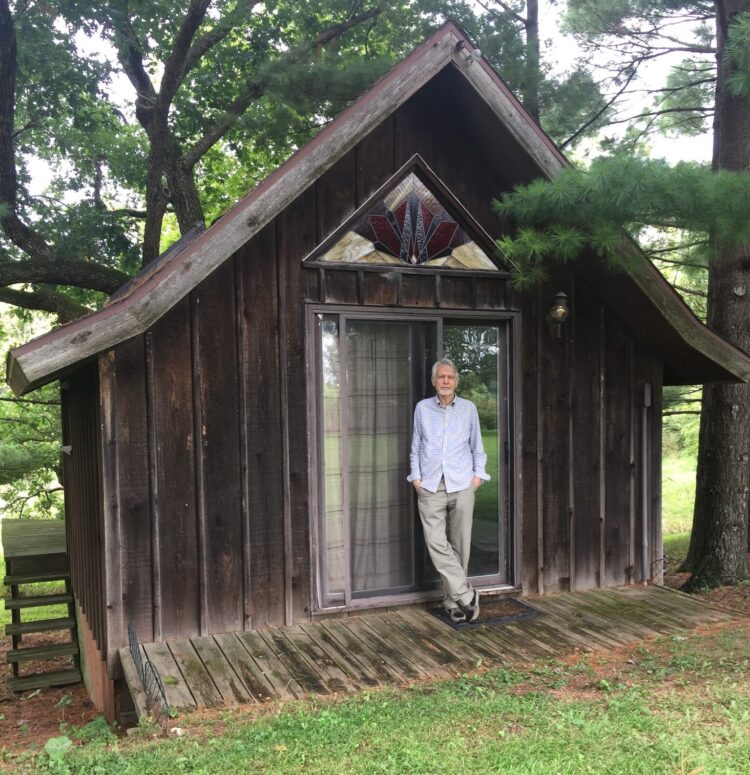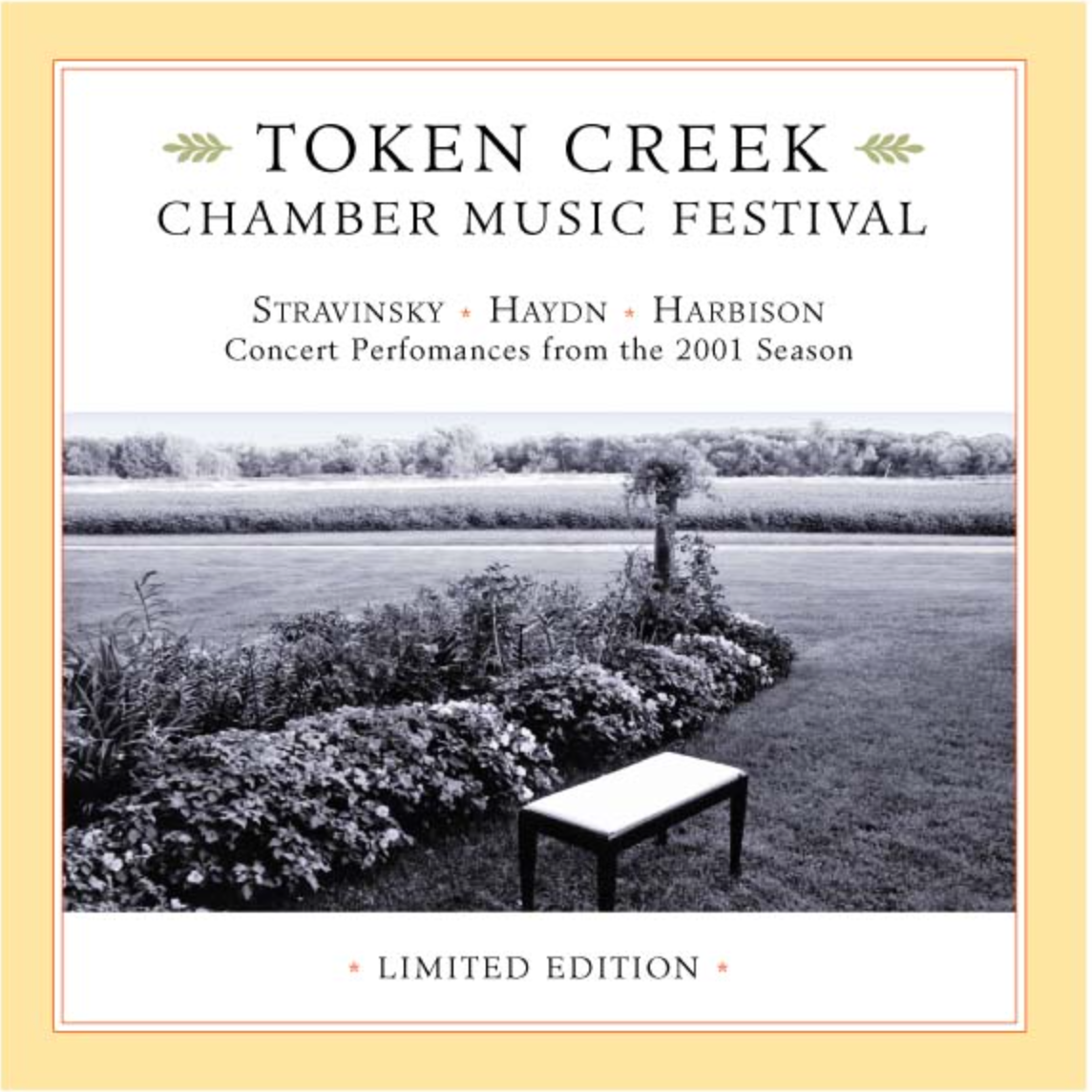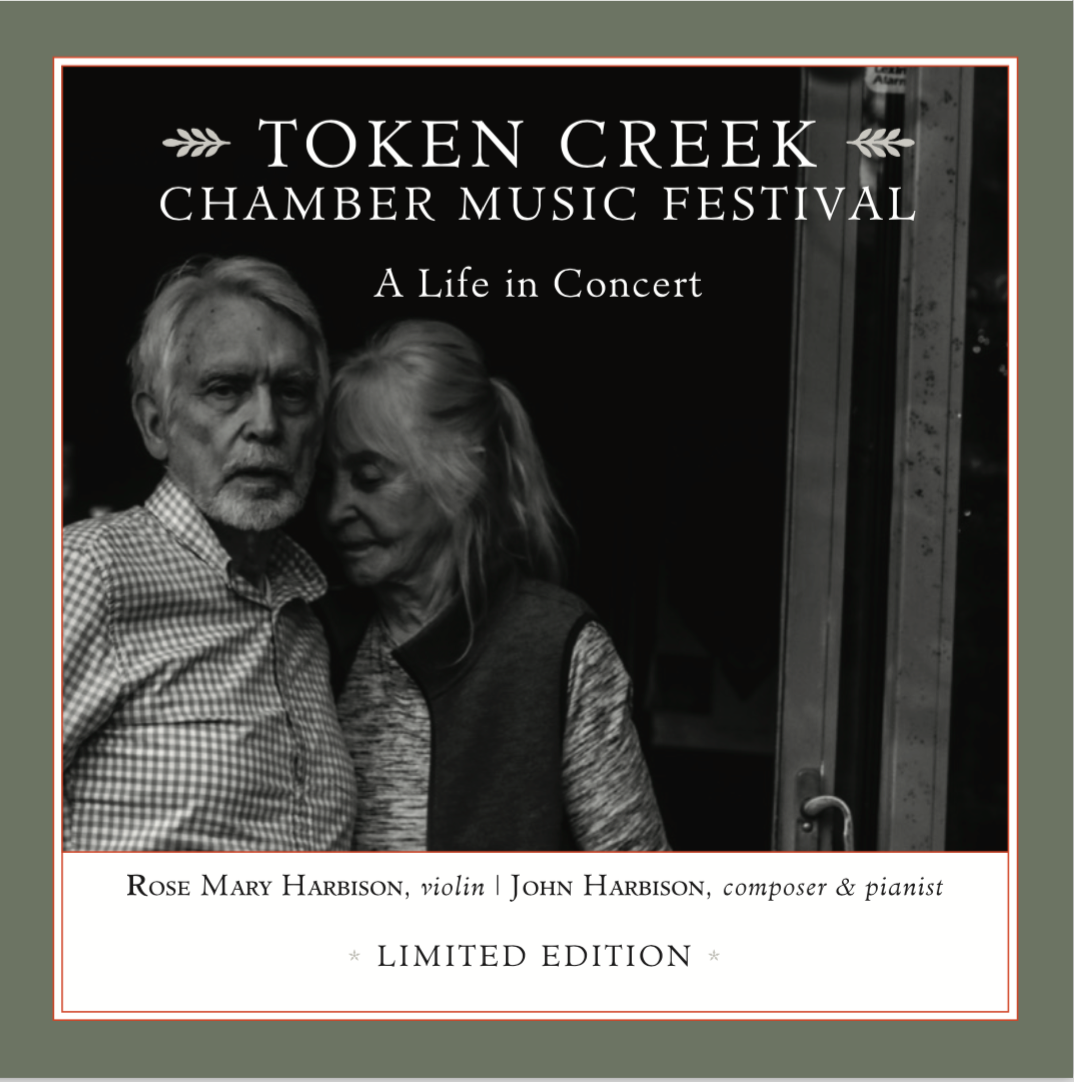TCF 2020 Virtual Season · Music from the Barn
John Harbison: Other Worlds
Texts
Program
Between Two Worlds (1991)(Robert Bly & Jakob Böhme) John Harbison (b. 1938) Part One The Two Worlds Hearing Men Shout at Night on MacDougal Street Hatred of Men with Black Hair Part Two The Various Acts of Poverty and Cruelty As the Asian War Begins Counting the Small-Boned Bodies Part Three In Praise of Grief Melancholia Part Four A Body Not Yet Born Looking at Some Flowers
- Marjorie Elinor Dix, soprano
- Rhonda Rider & Karl Lavine, 'cello
- Robert Levin & Judith Gordon, piano
- from the 2001 Token Creek Festival
(Henry Wadsworth Longfellow) Prelude The Cross of Snow Suspiria "Some Day, some day" Postlude
- Nathan Medley, counter-tenor
- Second City Consort of Viols
- Anna Steinhoff
- Craig Trompeter
- Russell Wagner, viol
- with Brady Lanier, viol
- from the 2016 Token Creek Festival
- Lucy Fitz Gibbon, soprano
- Ryan McCullough, piano
- from the 2015 Token Creek Festival
- Ya-Fei Chuang & Robert Levin, piano
- from the 2011 Token Creek Festival
Program Notes
Although the farm at Token Creek is the summer retreat of John & Rose Mary Harbison, and the site of the composition shack where a great many of Harbison’s works have been penned, the Token Creek Festival has never sought to program his music disproportionately to that of other composers. If anything, the TCF serves as a chance to explore other music, none more than that of J.S. Bach.
Any attempt to contain, in a few descriptive words, the vast range of Harbison’s music would inevitably prove woefully inadequate. The four works presented here offer just a glimpse into some of the very different compositional worlds of composer and artistic co-director, John Harbison, works that we have been privileged to encounter at the Token Creek Festival.
Between Two Worlds, on texts of Robert Bly, for soprano, ‘two cellos and two pianos, was written in response to civil unrest in the 1960s and to the lingering effects of “the Vietnam Syndrome,” dealing with “issues unresolved in our consciousness.” Composed at Token Creek, this extremely powerful work is as relevant now as when it was written. A joint commission of the Santa Fe, Ravinia, and Saratoga Festivals, the work premiered in summer 1991.
The Cross of Snow, for counter-tenor and viol consort, was a private commission of William Wartmann as a memorial tribute to his deceased wife. The Longfellow poems that serve as texts were written following the tragic death of his own wife. Harbison achieves exquisite idiomatic writing for the viols, and the counter-tenor voice ratchets up the poignancy of these ravishing songs.
Seven Poems of Lorine Niedecker sets texts of this important Imagist poet from Wisconsin, who lived in poverty in a river shack about an hour’s drive from the Token Creek farm. In Niedecker’s minimalist poems “we feel the pressure of what has been left out, the hard journey to final shape. We imply the ‘story’ behind it, and marvel at the courage and art that sets it down so briefly.”
Diamond Watch: Double Play for Two Pianos was commissioned for MIT economist Peter Diamond’s retirement. It is full of word play and double entendre, all inspired by “Diamond’s” love of baseball. Performed by pianists Robert Levin and Ya-Fei Chuang at Token Creek, it is an effervescent, witty, and fun conclusion to this all-Harbison program.
Although Harbison’s music is widely recorded on leading record labels, the Token Creek house label (TCR) is pleased to offer the world premiere — and only extant — recordings of several Harbison works, including those written for violinist Rose Mary Harbison, in authoritative performances by their dedicatee.
Our newest release, TCR 126, also include Four Songs of Solitude for unaccompanied violin, written for and performed here by Rose Mary Harbison.

Mr. Harbison’s composer’s notes
Between Two Worlds (1991)
In 1978 the Santa Fe Chamber Music Festival approached me with an idea for a piece based on documents left behind by the three civil rights workers, Goodman, Schwerner and Chaney, who were murdered early in the summer of 1964. One reason they asked me to do the piece was my participation in the Freedom Summer in Mississippi in 1964.
I declined, because I could not speak then, musically, for those events. Nevertheless, I have written Between Two Worlds, which deals with other issues from that time that I feel are still unresolved in our consciousness.
We are informed that “the Vietnam Syndrome” is over, but for many of the veterans of that war, and for those who simply witnessed from here at home, conflicts persist. I found that certain poems of Robert Bly that I read then were still haunting my memory. Finally, after many years they took the form of specific musical sounds, for an unusual group of instruments and a voice whose witness is more empathetic, cathartic, and “vocal” than it could be at that time.
Bly’s 1967 collection, The Light Around the Body, with its interludes taken from the fifteenth century mystic Jacob Boehme, identifies a crucial dilemma, the reconciliation of outward action with radical inwardness. It is around this center that all the musical ideas of the piece collect.
Between Two Worlds was commissioned by a consortium of summer festivals: Santa Fe Chamber Music Festival, Ravinia and Saratoga, for performance in the summer of 1991. It was composed in December 1990 and January 1991 at Token Creek, Wisconsin. The first performers were: Susan Larson, soprano; David Finckel and Andres Diaz, cellos; and James Tocco and Wu Han, pianos.
The Cross of Snow (2015)
The Cross of Snow, for counter-tenor (or contralto) and viol consort, was commissioned by William John Wartmann in memory of his wife, Joyce Frances Wartmann (1924-2003). The piece is scored for two treble viols, tenor viol, and bass viol, the latter not to be confused with the orchestral contrabass. An alternate adaptation for voice and string quartet has also been prepared.
A fortunate opportunity to meet the commissioner at his country home near Edgerton, Wisconsin offered a chance to discuss his ideas about text and instrumentation, ideas embodied in the final shape of the piece. Every detail of the Wartmann estate suggested a distinctive artistic stance. I was able to see and admire Mr. Wartmann’s achievements as painter and sculptor, as well as the paintings by Joyce Wartmann, who was also an accomplished singer.
The project, with so many elements unfamiliar to me, felt like a fortunate place to find myself. Mr. Wartmann’s preference for nineteenth-century poetry initially led me toward Hardy, Dickinson, and Whitman, but re-imagining my discussion with him led me instead to Longfellow’s “The Cross of Snow,” largeness of address combined with intimate personal feeling, which led naturally to other poems by the same poet, as well as the rather plain-spoken chorale settings which begin and end the piece.
Seven Poems of Lorine Niedecker (2014)
Lorine Niedecker (1903-1970) lived much of her life beside a flooding river in a small cabin without electricity or running water. She worked small, mostly secretarial jobs. Many who knew her did not know about her poetry.
More of a presence in England (Harrison Birtwistle made a song cycle from her poems in 1998), she is increasingly valued in the United States, with two recent biographies, and complete republication of her spare, strong-minded poems.
The Wisconsin terrain where I have done much of my work, near Token Creek, is not so different from her home-site, on Blackhawk Island near Fort Atkinson.
Seven Poems of Lorine Niedecker was composed in honor of Tanglewood’s 75th anniversary. It was designed to include the participation of a longtime friend and colleague, Ursula Oppens. Previous pieces composed for her include my Parodie-Fantasie (1968) and Piano Sonata (1987). She also played the premiere performances of The Flower-Fed Buffaloes (1976) and Variations (1982).
Niedecker’s poems are used with the kind permission of Bob Arnold, Literary Executor of the Estate of Lorine Niedecker.
About Lorine Niedecker
Lorine Niedecker (1903-1970) has been called the poet of place because her imagery is so grounded in the area where she lived. Basil Bunting called her “the Emily Dickinson of this century.” As an objectivist poet, the simplicity of her images helps us sense our own experiences with the elements around us. Lorine was strongly affected by her life on Blackhawk Island, surrounded by water. Her words weave the textures of her culture, family and neighbors. She is nationally and internationally known as a respected poet ranked among the twentieth century’s finest. (from Friends of Lorine Niedecker, Fort Atkinson, Wisconsin.)
Diamond Watch: Double Play for Two Pianos (2009)
Diamond Watch was fun to write, a piece for an occasion I envisioned as enjoyable, with cherished performers, attentive listeners, and a location I’ve grown to love even for its acoustics, Kresge Auditorium at MIT.
The dedicatee, Peter Diamond, is one of the world’s sovereign economists, but his other interests include baseball. I got to thinking about the various intersections between games, statistics, musical shapes, rules, frames, and predictions, and began imagining a series of variations.
In my favorite kind of variation the “theme” itself is not overtly stated. This is the idea of the baroque passacaglias: the bass and its harmony are the real source. Bach’s Goldberg Variations and his solo violin Chaconne proceed this way, as does Corelli’s La Folia.
I have previously written shadow-theme variations on a large scale, for violin, clarinet and piano, and quite brief, in my second piano sonata (for Robert Levin). This one is somewhere between those in duration, about twelve minutes. The movement titles offer a heavy hint as to the origin of the ground.
One amusing aspect of the piece more available to the performers than the listeners is the graphic representation of diamonds in the variation called “Diamond daze.” I think of it as an analogy to the representation of the dedicatees as part of the composition in Renaissance paintings and, as such, an acknowledgement of Kate Diamond’s keen participation in the conception of this project (Kate was for many years a Curatorial Associate at the Museum of Fine Arts, Boston).
Diamond Watch was commissioned by Priscilla (Kate) Myrick Diamond as a birthday present for Peter Diamond, and in honor of his retirement from the Massachusetts Institute of Technology, for a first performance by Robert Levin and Ya-Fei Chuang at Kresge Auditorium on April 30, 2010.
Available on CD
TCR 114 Stravinsky – Haydn – Harbison
features Harbison’s Between Two Worlds, on today’s program.

This unique, limited-edition recording of live performances from our 2001-2005 seasons is available for purchase from our online store while supplies last.
Click here to order.
TCR 126 A Life in Concert: John & Rose Mary Harbison
features Schoenberg’s Phantasy performed, as in this program, by Rose Mary and John Harbison

This unique, limited-edition recording is available for purchase from our online store while supplies last.
Click here to order.